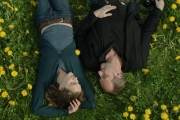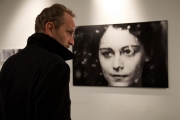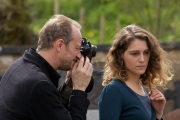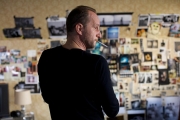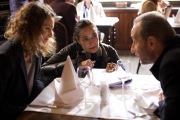Synopsis
Antoine is a talented yet airily-disillusioned photographer. His only friend is little Mateo, the young son of his often-absent neighbor to whom he gives a whimsical education in people, photography, and life. One morning, the sound of a piano being played in the building opposite his apartment captures Antoine’s attention. He does not know then that the person playing, Elena, an idealistic and uncompromising student, will turn his life upside down and help him find a place on Earth…
Credits
Director: Fabienne Godet
Screenplay: Fabienne Godet, Claire Mercier, Franck Vassal
Producers: Bertrand Faivre, Sophie Quiédeville
Cast
Benoît Poelvoorde • Ariane Labed
Max Baissette de Malglaive
Schedule & Presentation
![]() Presentation by and discussion with director and screenwriter Fabienne Godet
Presentation by and discussion with director and screenwriter Fabienne Godet
More information
Choose a picture to see the filmography (source : IMDB)
![]()
In Une place sur la Terre, each character struggles to find their place.
Yes, it is something like a carousel that continues to turn and turn. The supporting characters around Antoine and Elena are in a sort of precarious equilibrium. They enter and leave the scene in their search to rediscover themselves or simply to find themselves for the first time.
The photos of Elena that Antoine takes are actually the work of the well-known American photographer, Michael Ackerman.
It was essential that the photos reflect the quality of talent I imagined Antoine having in the film. So, I tasked myself with finding a really strong photographer. Ackerman’s work reflects the desire to recreate a depth of emotion and sensory experience that I was looking for with this particular movie.
Who were your inspirations while making this film?
I had Munch’s piece, The Scream, in mind through the entire writing process. Munch does not show, he expresses, and that is what I tried to hold on to throughout the film.
As for the image, I wanted to style the film through colors in order to be as close as possible, not to reality necessarily, but to the emotional truth of my characters. The paintings of Hooper and films by Wong Kar-Wai (like Happy Together) helped me to find the unique and vibrant world of this film.
There was clearly a lot of work put into the soundtrack of the film. And the second half of the film featured music composed by Philip Glass.
The film opens with Chopin’s opus 10, No. 12. It is through this music that Antoine first intrudes into Elena’s life. [...] I wanted each character to have his or her own musical world, and those worlds to clash from time to time. I also wanted to create a musical collage of sorts … that the music of the external world disrupts the music of the inside and, conversely, that the inner music overrides the outside one.



